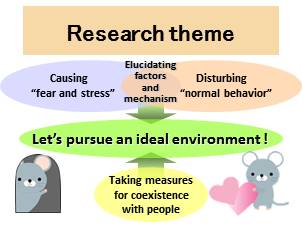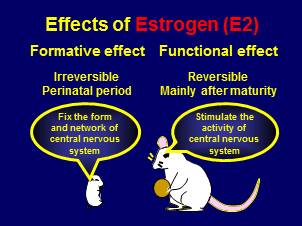Our laboratory aims to propose a happy environment of humans and animals
and presents three themes.
" To assess the environmental factor which cause behavioral dysfunctions,
e.g. chemical compounds, and stress. "
" To identify methods for acquiring new beneficial body characteristics, e.g. stress tolerance. "
" To clarify the neuroendocrine mechanism regulating behaviors such
as anxiety, sociality, learning and food intake. "

As part of the themes mentioned above, we expose rats to estrogenic compounds
within hours of birth, and then assess the effects on behavior. There are various chemical compounds in the environment that can affect
humans and domestic animals. Some of these chemicals mimic the effects
of natural hormones and so can interfere with endocrine systems. Domestic
animals can be exposed to these endocrine disruptors in the form of hormone
preparations, ingredients or preservatives contained in animal feed, as
well as some pesticide residues. One of these endocrine disruptors is estrogen.
It can cause formative and functional changes in rodent brains.

The formative effect of estrogen is irreversible and happens during the developmental stage. It acts on the nervous system when it is undeveloped and rich in plasticity, and the resulting form of the neuron and neural network cannot subsequently be altered. Thus, normal differentiation of the brain can be inhibited by exposure to chemical compounds having estrogenic activity during the developmental period. On the other hand, the functional effect of estrogen stimulates neuron and neural network activity, and many of these activities are reversible. There are a wide range of neural mechanisms affected by estrogen, such as those related to reproduction, food intake, emotion, high-order function. However, the precise timing and mechanisms underlying these effects is not yet fully understood. Therefore, in this study we focused on estrogen exposure to female rats within 24 hours of birth, and analyzed the effects on learning behavior, anxiety-related behavior, feeding behavior and sexual behavior. From these studies we have revealed that a single neonatal exposure to 17α-ethinyl estradiol (EE) (2 mg/kg) disturbs the normal development of the female brain. It resulted in impaired sexual behavior (Komine et al, 2017. Journal of Applied Toxicology.), and also a decline in passive avoidance performance that was apparent even at a 1/100 dose level (0.02 mg/kg EE) (Shiga et al, 2016. PLoS One. 11:e0146136.).
Introduction of research methods
In our laboratory, we have mainly been working on research using an ethological
analysis approach.
Some of the experimental methods being used in our laboratory are listed
below.
Elevated plus maze test
The elevated plus maze test measures anxiety-related behavior in rodents. It is conducted using cross-shaped apparatus that is elevated 50-60 cm above the floor. The cross shape is formed by two open arms and 2 closed arms. The test measures the number of entries and the time spent on each arm. Anxiety is demonstrated by the animal spending more time in the closed arms, and thus anxiety-related behavior can be examined. Our research indicate that arm structure (presense/absense of ledges on the open arm and/or the transparency/opaqueness of walls on the closed arm) significantly influences maze-exploratory behavior in rats (Horii et al, 2015. Behavioral Brain Res. 294: 131-40).Laboratory of Animal Behavior and Environmental Science動物環境学研究室
1-1-1 Higashi-Mita, Tama-ku, Kawasaki-shi, Kanagawa 214-8571
MejiUniversity, Ikuta Campus
Area 1 Building-5, Room No.502
TEL +81-44-934-7827
FAX +81-44-934-7827